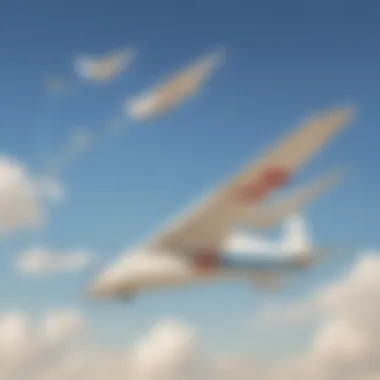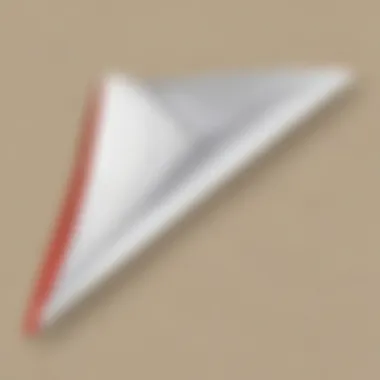Unveiling the Intricacies of Paper Airplane Experimentation: A Scientific Exploration


Science Fun Facts
Do you know that the longest distance flown by a paper airplane is 226 feet and 10 inches, achieved by Joe Ayoob and designed by John Collins? This incredible feat was accomplished on February 26, 2012, in California, USA. Paper airplanes come in various designs, such as dart, glider, and stunt plane, each performing differently based on aerodynamic principles.
Discover the Wonders of Science
Exploring the world of paper airplane experimentation reveals fascinating scientific concepts like aerodynamics and weight distribution. Educational videos and animations can visually demonstrate how air pressure affects flight patterns, while real-life applications of science showcase the significance of principles like lift and drag in aviation.
Science Quiz Time
Challenge your knowledge of paper airplanes with interactive quizzes and brain teasers. Can you identify the factors affecting a paper airplane's flight duration? How does the angle of launch impact its distance traveled? Engaging in gamified learning can enhance understanding of concepts like air resistance and balance.
Science Experiment Showcase
Get ready to embark on a paper airplane experiment adventure! Follow step-by-step instructions to craft different designs, from classic gliders to aerobatic models. Ensure to have materials like paper, scissors, and rulers ready, and always prioritize safety by conducting experiments in a controlled environment away from hazards.
Introduction
Peek into the fascinating realm of paper airplane experimentation where young minds can soar through the expanse of scientific exploration. In this article, we embark on a journey that unravels the scientific intricacies behind the art of crafting and testing paper airplanes.
Importance of Paper Airplane Experimentation
Diving deeper, let's explore how paper airplane experimentation plays a pivotal role in nurturing scientific curiosity, fostering hands-on learning experiences, and delving into the captivating realm of aerodynamics.
Enhancing Scientific Curiosity
Venturing into the realm of enhancing scientific curiosity unveils a world where inquisitive minds bloom. This aspect ignites a passion for discovery and instills a knack for questioning the 'hows' and 'whys' of flight dynamics. By fostering a sense of wonder and curiosity, young enthusiasts can pave the way for groundbreaking scientific endeavors.
Encouraging Hands-On Learning
Hands-on learning strikes at the core of experiential education, allowing young minds to bridge the gap between theory and practice. It empowers learners to explore concepts actively, fostering a deeper understanding of scientific principles. By engaging in tactile experiences, learners grasp complex ideas with ease and develop essential problem-solving skills.


Exploring Aerodynamics
Unraveling the mysteries of aerodynamics sheds light on the principles that govern flight. By delving into the intricate relationship between air resistance, wing shape, and folding techniques, participants gain insight into the science behind flight. This exploration not only sharpens analytical skills but also sparks a curiosity for understanding the invisible forces that shape the trajectory of paper planes.
Overview of Paper Airplanes
Embark on a historical expedition as we trace the origins of paper airplanes, explore the myriad types available, and delve into the fundamental principles of flight.
History of Paper Airplanes
Delve into the past to discover how paper airplanes have evolved from simple folds to dynamic designs. Understanding the historical context of paper aviation provides a glimpse into the creativity and ingenuity of early aviation enthusiasts. By revisiting the origins of paper planes, participants gain a deeper appreciation for the craft's evolution.
Different Types of Paper Airplanes
Explore the diverse world of paper airplane designs, from sleek gliders to acrobatic stunt planes. Each type presents unique characteristics that influence flight performance and aesthetics. By familiarizing themselves with various designs, participants can experiment with different styles and understand how form intersects with function in the realm of paper flight.
Basic Principles of Flight
Grasp the foundational principles underpinning the art of flight as we dissect lift, drag, and thrust. Understanding these basic concepts equips participants with the knowledge to optimize their paper airplane designs for enhanced performance. By mastering the principles of flight, budding aviators can elevate their creations to new heights of aerodynamic excellence.
Significance for Young Science Enthusiasts
For young science enthusiasts, the journey of paper airplane experimentation offers a gateway to the world of physics, a platform for hands-on experimentation, and a canvas for creative expression.
Engaging Introduction to Physics
Embark on a thrilling voyage into the realm of physics, where the laws of motion and energy unfold in the graceful dance of paper planes. By immersing themselves in practical applications of physics principles, participants bridge the gap between theoretical concepts and real-world phenomena. This engaging introduction lays the foundation for deeper exploration into the wonders of the physical universe.
Encouraging Experimentation
Embrace the spirit of experimentation as young aviators take flight with their creative designs. Encouraging experimentation cultivates a mindset of exploration and innovation, allowing participants to test hypotheses, iterate on designs, and refine their understanding of aerodynamics. Through hands-on trial and error, participants unlock the secrets of flight and cultivate a spirit of scientific inquiry.
Opportunities for Creativity


Unlock a world of endless possibilities where imagination takes flight on the wings of paper creations. Opportunities for creativity abound in the realm of paper airplanes, offering participants a platform to infuse their designs with personal flair and innovation. By encouraging creative expression, this aspect nurtures individuality and inspires participants to push the boundaries of traditional design paradigms, charting new territories in paper aviation.
Understanding Aerodynamics
Key Principles of Aerodynamics
Air Resistance and Lift
Air resistance and lift are fundamental concepts in aerodynamics that significantly influence the flight of paper airplanes. Air resistance, also known as drag, is the force acting against the forward motion of the aircraft. Lift, on the other hand, is the force that keeps the airplane aloft by counteracting the weight of the plane. When designing paper airplanes, understanding how to minimize drag while maximizing lift is key to achieving longer and smoother flights. By mastering the balance between these two forces, enthusiasts can improve the overall performance of their paper airplanes.
Impact of Wing Shape
The impact of wing shape on aerodynamics is remarkable. Different wing shapes, such as delta wings or straight wings, alter how air flows around the airplane, affecting lift and drag. The choice of wing shape can determine the stability and maneuverability of the paper airplane. For example, delta wings are known for their agility, while straight wings offer better lift. By experimenting with various wing shapes, enthusiasts can tailor their designs to meet specific flight objectives, whether it be distance, speed, or acrobatics.
Effect of Folding Techniques
Folding techniques play a pivotal role in aerodynamic performance. The way paper is folded and creased can determine the smoothness of airflow over the wings and body of the airplane. Sharp folds can create turbulence, increasing drag, while precise folds can enhance lift. Understanding the effect of folding techniques allows designers to optimize their paper airplane's aerodynamics for efficient and stable flight. Experimenting with different folding methods offers insights into how small adjustments can lead to significant improvements in flight characteristics.
Testing and Data Analysis
Setting Up Flight Experiments
Creating a Controlled Environment
Creating a controlled environment is a pivotal aspect of setting up flight experiments when delving into the intricacies of paper airplane flight. By controlling variables such as wind conditions and launch angles, researchers can ensure that any observed results are due to the changes made in the experiment, rather than external factors. This meticulous approach enhances the reliability and reproducibility of the findings, crucial for drawing accurate conclusions.
Measuring Flight Distance
Measuring flight distance is an essential component of flight experiments, providing valuable quantitative data for analysis. By accurately determining how far a paper airplane travels, researchers can assess the impact of design modifications on flight performance. This data serves as a tangible outcome of the experiment, aiding in comparing different airplane designs and identifying trends in flight behavior.
Recording Flight Patterns
Recording flight patterns involves capturing the trajectory and behavior of paper airplanes in motion. By documenting the flight path, researchers can analyze the stability, lift, and aerodynamic efficiency of different designs. This qualitative data complements quantitative measurements, offering a comprehensive view of how various factors influence the flight performance of paper airplanes.


Recording and Interpreting Results
Analyzing flight data is a critical step in the testing and data analysis process during paper airplane experimentation. By examining variables such as flight distance, time of flight, and flight patterns, researchers can derive valuable insights into the aerodynamic principles at play. Identifying trends in the data allows for a deeper understanding of how design changes impact flight performance, facilitating informed decision-making for future experiments.
Iterative Experimentation Process
The iterative experimentation process involves refining designs based on results, implementing changes for improvement, and repeating tests for validation. By iteratively iterating on design modifications, researchers can optimize the performance of paper airplanes, enhancing stability, distance, and accuracy. This structured approach fosters a cycle of continuous improvement, encouraging young scientists to experiment, analyze outcomes, and refine their designs to achieve better results.
Conclusion
In the realm of paper airplane experimentation, the conclusion serves as a pivotal moment where various facets coalesce to encompass the essence of the scientific journey undertaken. Through the meticulous exploration of aerodynamics, flight patterns, and testing methodologies, young science enthusiasts gain a profound insight into the fundamental principles that govern paper aircraft's flight. The educational benefits encapsulated within this conclusion extend far beyond simple entertainment; they cultivate a fertile ground for nurturing critical thinking skills, fostering a keen interest in STEM fields, and promoting invaluable hands-on learning experiences.
Educational Benefits of Paper Airplane Experimentation
Enhancing Critical Thinking Skills
As young minds engage in the art of paper airplane experimentation, a notable focus lies on the enhancement of critical thinking skills. This aspect plays a crucial role in honing problem-solving abilities, decision-making processes, and analytical reasoning. By challenging individuals to evaluate flight patterns, design variations, and performance outcomes, the process instills a deep sense of logical reasoning and strategic planning. The unique feature of enhancing critical thinking lies in its ability to encourage a structured approach towards experimentation and testing, thereby fostering a mindset inclined towards scientific inquiry and exploration.
Fostering Interest in STEM Fields
The pathway illuminated by paper airplane experimentation is one that leads aspiring individuals towards a profound appreciation for STEM fields. By immersing oneself in the nuances of aerodynamics, flight dynamics, and engineering principles, a natural curiosity for science, technology, engineering, and mathematics is kindled. The key characteristic of fostering interest in STEM fields stems from its ability to bridge theoretical concepts with practical applications, thereby igniting a passion for discovery and innovation. While navigating through the intricacies of paper aircraft construction and flight testing, individuals cultivate a deeper connection with the realms of science and technology.
Promoting Hands-On Learning Experiences
At the heart of paper airplane experimentation lies a profound emphasis on immersive, hands-on learning experiences. By actively engaging in the design, construction, and testing phases, participants embark on a tactile journey that reinforces theoretical knowledge with practical application. The key characteristic of promoting hands-on learning experiences rests in its capacity to enhance experiential learning, spatial awareness, and fine motor skills. Through the medium of paper airplanes, individuals are encouraged to embrace trial and error, cultivate dexterity, and unravel the mysteries of flight in a tangible, interactive manner.
Future Exploration and Application
Applying Principles to Other Projects
The crossover between paper airplane principles and other projects unveils a realm of endless possibilities and creative innovation. By extrapolating aerodynamic concepts, design strategies, and testing methodologies from paper aircraft experimentation, individuals can aptly apply these principles to diverse fields and projects. The key characteristic of applying principles to other projects lies in its adaptability and versatility, enabling individuals to decode complex scientific principles and translate them into practical solutions. Whether venturing into rocketry, aeronautics, or structural engineering, the foundational knowledge gleaned from paper airplane experimentation serves as a stepping stone for future endeavors.
Encouraging Further Scientific Inquiry
The spirit of scientific inquiry ignited through paper airplane experimentation paves the way for continual exploration and discovery. By fostering a culture of curiosity, observation, and hypothesis testing, individuals are encouraged to delve deeper into the realms of aerodynamics, physics, and engineering. The key characteristic of encouraging further scientific inquiry lies in its capacity to stimulate intellectual curiosity, inspire rigorous experimentation, and drive innovation. Through the lens of paper aircraft design and testing, participants are propelled towards uncovering new insights, refining existing theories, and pushing the boundaries of scientific knowledge.
Inspiring Innovation Through Experimentation
The nexus of innovation and experimentation merges seamlessly within the domain of paper airplane exploration, as individuals navigate the realms of creativity, problem-solving, and ingenuity. By fostering a mindset that embraces trial and error, lateral thinking, and unconventional problem-solving approaches, paper airplane experimentation becomes a catalyst for innovative thinking. The unique feature of inspiring innovation lies in its propensity to challenge conventions, spark creativity, and redefine traditional boundaries. Through the iterative process of design refinement, performance optimization, and data analysis, individuals are empowered to think outside the box, experiment fearlessly, and pave the way towards inventive solutions.







